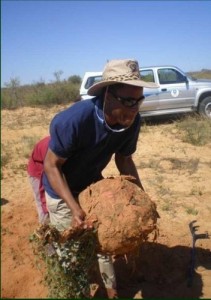Often called ‘magic’ marama, the green gold of Africa, this plant is working its secret charm above and below ground in southern Africa. Above ground it produces seeds similar to the peanut or soybean, but is actually higher in nutritional value than either; below ground it produces a high-protein tuber that is bigger and healthier than potatoes, yams or sugar beets. And to top it off, the planet can also generate a high quality vegetable oil.

Native to the Kalahari Desert across Botswana, Namibia and South Africa, marama has been a part of the diet of the indigenous people in the area for the generations. And yet, it has not been introduced into wide range cultivation and remains one of the most neglected indigenous vegetables in Africa.
Nutritious beans and tubers aren’t the only benefits. The plant thrives in the poor quality, sandy soil of the desert, withstanding blistering summer temperatures, freezing nights of the Kalahari winters, and highly erratic – and often absent – rainfall. While marama seeds are virtually inedible straight from the pod, they are delicious once they harden and are often roasted, compared to the nutty flavor of cashew nuts. In addition to the oil that can be produced from the seeds, the plant is particularly good fodder for livestock.
And the nourishing possibilities aren’t restricted to food. The plant likely survives its dry ecosystem by storing water in its tubers, which hold immense amounts, even up to 250 kg. In arid regions they are often referred to as “living cisterns” that provide an emergency source of water.
In addition to being a weapon to fight malnutrition by providing high level concentrated and protein and energy in a region where food security is a high priority, the plant is also capable of battling desertification. The highly drought-tolerant plant sprawls across land, it creates biomass that protects the soil from erosion.
While most agronomists agree that it is not yet ready for large-scale cultivation, the research is badly needed to learn management techniques that would harness the plant’s enormous potential in the right environments. Given its affinity for dry areas, testing it in projects aimed at alleviating rural poverty and malnutrition in the drought-prone areas in southern Africa could have great results in mitigating climate change.
To learn more about crops indigenous to Africa, see: The Locust Bean: An Answer to Africa’s Greatest Needs in One Tree, Moringa: The Giving Tree, Black-eyed Peas to the Rescue,The Taming of the Dika: West Africa’s Most Eligible Wild Tree, Amaranth: Food Production Without Attention, African Eggplant: The Fruit that is Enjoyed as Vegetable, The Little Legume That Could, and The Locust Bean: An Answer to Africa’s Greatest Needs in One Tree.
Amanda Stone is the communications assistant with the Nourishing the Planet project.

Danielle Nierenberg, an expert on livestock and sustainability, currently serves as Project Director of State of World 2011 for the Worldwatch Institute, a Washington, DC-based environmental think tank. Her knowledge of factory farming and its global spread and sustainable agriculture has been cited widely in the New York Times Magazine, the International Herald Tribune, the Washington Post, and
other publications.
Danielle worked for two years as a Peace Corps volunteer in the Dominican Republic. She is currently traveling across Africa looking at innovations that are working to alleviate hunger and poverty and blogging everyday at Worldwatch Institute’s Nourishing the Planet. She has a regular column with the Mail & Guardian, the Kansas City Star, and the Huffington Post and her writing was been featured in newspapers across Africa including the Cape Town Argus, the Zambia Daily Mail, Coast Week (Kenya), and other African publications. She holds an M.S. in agriculture, food, and environment from Tufts University and a B.A. in environmental policy from Monmouth College.








